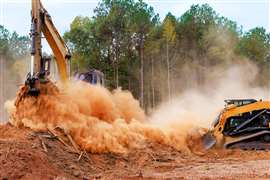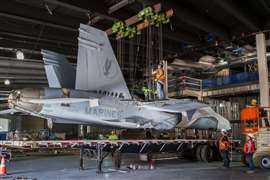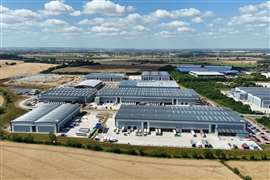Wide scope
25 April 2008
Telescopic hydraulic gantries have been in use since the 1960s and commercially available since the early 1980s. Typical applications are to lift and move heavy and awkward loads, often in confined site conditions, especially where headroom is restricted.
A factor that often clinches the deal in favour of an hydraulic gantry is time saved over other lifting methods. Up to four days of machine downtime were saved on a recent project in the US. In March contractor SKV LLC from Wyoming used a telescopic hydraulic gantry system for a hardware changeout project on a P&H 2800 coal mining shovel.
A set of eight units of US manufacturer J&R Engineering's Lift-N-Lock T1802-8-39 gantries was used to separate the upper and lower sections of the mining shovel to gain access for structural repair and upgrade work. The 1,043 tonne load was raised 5 m to give the necessary clearance. Swing components, including ring gear, rollers and rails were replaced.
Hydraulic gantry systems as an alternative to heavy lift cranes were instrumental to the success of a US$ 200 million plant expansion project in India.
Indo Rama Synthetics (India) Limited is a leading Indian manufacturer of polyester and related textiles and has a big plant at Nagpur in the western part of India. As part of its expansion plan, Indo Rama is doubling the capacity of the plant from 800 tonnes of polyester and related product per day to 1,600 tonnes a day.
India-based Freight Wings was contracted to install heavy equipment that included two each of the following; 125 tonne disc ring reactor (DRR), 70 tonne polycondensation reactor and 65 tonne esterification reactor. While these last two were to be lifted vertically (like refinery columns) and installed at 14 m elevation, the lifting and installation of the DRR was a challenge.
The DRR had to be lifted to a height of around 14 m and installed inside a building where the height difference between the floor and the top deck inside the building was 6 m. The DRR had to be skidded on a floor with a lower elevation of 14 m and a top elevation of 21 m with a height clearance in between of 6 m. The DRR measured 13.6 x 4.37 x 4.7 m and weighed 125 tonnes.
Using a crane was out of question, Freight Wings' Amit Koul explains, due to the site constraints and the fact that the foundation was well inside the building. A requirement was to lift and travel the load within the 6 m height clearance so Freight Wings devised a combination hydraulic gantry and strand jack method.
“Overcoming these constraints, we came up with a unique solution of using a combination of our computer controlled strand jacks (2 x 185 tons SWL) and 4 Point Lift System (500 US ton [454 tonne] capacity) for this lift,” Koul explains. Freight Wings used its two 300 tonne Modular Lifting Towers and mounted the runway tracks for the gantries and skid beams on top. Using the strand jacks, the DRR was lifted close to its foundation elevation and the final lift was done using Freight Wings' 4 Point Lift System from Lift Systems in the US.
After lifting the DRR above its foundation it was lowered onto skid tracks. Using Teflon pads and a push-pull cylinder, the DRR was skidded over its foundation, which was at a height of 2,200 mm, and lowered onto it using hydraulic jacks.
The complete lifting & skidding operation was completed in two days. Kvaerner Power & Gas was the consultant and it checked and approved Freight Wings' design and engineering prior to the lift. The Polycondensation Reactor was erected using strand jacks and the same for the esterification reactor.
As with other types of lifting equipment, computers have found their way into hydraulic gantry systems. Hydraulic gantries usually operate in pairs or sets of four or more leg units and computer synchronisation is one way to ensure the legs all lift together.
In Australia, Crains Machinery Transport recently demonstrated the value of computer synchronisation on a project for Dana in Melbourne. Crains has been using its four leg system with built-in computerised synchronisation from Dutch manufacturer Hydrospex for two years. The job for Dana, which makes metal and plastic automotive components, was to lift and place a Hyundai 1,500 tonne press. “The press was unloaded from transport and lifted into position with the four jacks, starting with a third of the press placed into a pit and built up from there,” Steve Crain explains.




